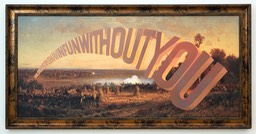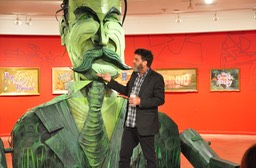Multi-disciplinary artist Wayne White (puppeteer, animator, painter, set designer, art director) and curator Jane Hart describe aspects of his residency and exhibition of "Word paintings" at the Art and Culture Center of Hollywood, Florida.
In Hollywood, the wacky, ironic exuberance of Wayne White’s World
Wayne White paced the enclosure rimmed by the long arms of a giant puppet sculpture he had just installed in the main gallery at the Art and Culture Center of Hollywood as he preached to about 75 students, artists and patrons. Among his sage exhortations (peppered with f-bombs): “Do what you love!” “Don’t quit!” “Take a risk!” “Never throw anything away!”
White’s lessons are hard-won. The Tennessee-born artist’s career has careened around sharp curves, scraped guardrails and, at times, run out of gas. He has been exalted and dismissed and resurrected. He’s a sculptor, painter, set designer, puppeteer, art director, music video animator and now also a popular artist-in-residence.
Jane Hart, the center’s former long-time curator of exhibitions, has followed his career “forever.” After his knockout appearance two years ago during the center’s Hot Topics lecture series as an arts coach and artist, she was determined to bring him back. This time, Hart secured prestigious NEA funding for a residency — coinciding with Broward County’s centennial — and exhibition that runs through Aug. 23.
Production for his show, Art is Supposed to Hypnotize You or Something was a 10-day frenzy, executed by White and a crew of regional art students. Laminated cardboard was transformed into an ebullient caricature of the controversial “drain that abominable swamp” 1905 Florida governor, Napleon Bonaparte Broward, and a marshland of unique Everglades creatures. Volunteers mounted a puppet procession from Young Circle to the Art Center for the July exhibition opening. White favors cardboard because, he said, “It’s democratic. Everybody has cardboard. It’s cheap; it’s fast; you get a lot of bang for your buck.” It’s a working method that breaks down barriers between “high” and “popular” art.
The Governor Broward sculpture is in the mold of others — like LBJ, John Brown and George Jones — that White has created countrywide: unconventional heroes connected to regional history. The research and community engagement that underlie these works characterize White’s method. Make it fun; make it intimate; don’t be afraid. That was his approach with Broward. As a former riverboat captain, gubernatorial candidate Broward was a long shot in 1904. He didn’t campaign in urban areas because of city newspapers’ hostility. Instead, he pursued the country folk with a plain-spoken populist message.
A larger-than-life, outsider character himself, White has garnered international exhibitions and important collectors while presenting himself as an “aw shucks” country boy. Both his populist anti-establishment, anti-commercial attitude and seriocomic demeanor run deep. “I’m not concerned about the longevity of the object,” he said in an interview. Neither the cardboard of his sculptures nor the lithographic prints into which he introduces painted texts (his “Word” paintings) is archival. Regarding his Broward puppet, he said, “The experience of making it, the experience of working with other artists, the initial experience of seeing it come to life and seeing it being performed in public — that’s enough. … And now, goodbye.”
Although he has enjoyed the “delicious little irony” of casting some of his cardboard forms in bronze, his legacy may well reside in inspiring others with his spontaneous working method and uninhibited creative attitude.
White has trod a circuitous and occasionally torturous path. It began in Chattanooga, Tennessee, and White is quick to assert that the “art collection” that graced the family’s walls came from K-mart. But those decorative landscapes, florals and history scenes made an impression that would later emerge and flourish. As a child, White loved to draw, and cartoonists were his first art heroes. Drawing remains his starting point for work in any genre. When he was still a child, a car crash seriously injured his mother. “I got a real first taste of how cruel the world could be.” This event pushed him further toward cultivating a fantasy life.
Later, the art program at Central Tennessee State exposed him to the “real” art of the abstract expressionists and the full gamut of art history. During the 1970s anti-war fervor, the raunchy “underground” comic scene was a further inspiration. “We were all small-town kids that finally found kindred spirits,” White recalled. But following the comfortable ambience of college, where he once created a puppet show instead of a term paper, White boldly moved to New York. “Take a risk. It’s always worked for me,” he urged his Art Center audience.
In New York, White scratched out a living creating cartoons for The New York Times, Village Voice and Raw magazine. He assisted in the studios of influential cartoonist Art Spiegelman (Maus) and legendary pop artist Red Grooms (whose kinetic sculpture at Marlins Stadium whirls when the home team hits a home run), whom he considers his most important influence. “Even the style and the look of [my] things is that blend of cartooning and German expressionism and the cubist fracturing and the energy; it’s all Red.”
White met and married the already-famous cartoonist/writer Mimi Pond in New York, and the creative energy of their relationship has “infected” their children, who also are artists. His big career break came on a long shot. Recruited back to Tennessee to invent sets and props for a public television music series for kids, White successfully revived his puppetry chops and demonstrated his skill. The result: a New York gig designing sets and characters for comic television star Paul Reubens’ Pee-wee’s Playhouse, the 1980s Emmy-winning, convention-defying phenomenon.
White calls it “a downtown art project that just happened to be shown on network TV.” Collaborating with a fearless team, White’s technical and inventive skills exploded. Nothing was too bizarre for Reubens. Another critical White lesson: “Find a good boss who will let you be creative.” After one chaotic but brilliant season in New York, Reubens brought the production to Los Angeles, where the Whites still live.
Each of White’s diverse creative talents feeds the others and gives him fresh eyes. He defies the classic admonition “do one thing, but do it well.” In contrast to his quickly fabricated cardboard sculptures, the Word paintings are time-intensive. They combine two more of White’s tenets: “Try anything!” and “Don’t throw anything away!”
After burning out on the soulless Los Angeles television scene that followed his Playhouse stint, White began a series of realist paintings. He would buy thrift store reproductions just for their frames. One day he thought, “Why not take a shortcut and paint over the art?” That art was much like the K-mart reproductions of his youth.
As an offhand spoof of renowned artist Ed Ruscha’s text-based work, White began inserting cynical and nonsensical words and phrases into these appropriated reproductions. Plying “Old World” painting skills, he carefully adopts the light conditions of the underlying landscapes, still lifes or battle scenes while modeling his monumental sculptural letters. The texts are completely subversive but paradoxically respectful. As Hart noted, “The nature of the font that’s employed evokes the nature of the phrase. Some are very bold; others are very fluid; some are frilly; some are funky.”
Most share an element of irony.
One of these on view is called Good Looking People Having Fun Without You. Its sardonic humor is thrust upon the viewer by the title set of letters arcing forward over an array of Civil War skirmishers in a deep landscape and against a pastel sky. Cannon smoke silhouettes one group of cavalry; another charges in from forest to field beneath the graceful floating letters. White’s paintings incorporate historical and popular image “sampling” among his creative tools, but in a lighthearted manner.
While not averse to complex, intellectual issues, White rebels against pretension. “Why does it have to be so priestly?” he challenges. He considers humor a potent vehicle for truth-telling. “If you can get someone laughing, you can open their minds.” The important issues bridge high and low designation. “Life is not an exalted thing; life is a daily struggle, and I think humor expresses that best.”
In the Center’s main gallery, the paintings and drawings hang on a red-painted and graffiti-ornamented wall, encircling the Broward sculpture.
Still Hot depicts a precariously balanced aerial construction reminiscent of mid-century Swiss/French artist Jean Tinguely’s complex kinetic sculptures. White floats these sculptural forms amidst warm-hued clouds.
Because his Word paintings were deemed “silly” by art aficionados, White initially didn’t dare offer them to the gallery system; instead, he showed in a Los Angeles diner called Fred’s 62, where Hart recognized their potency. Despite White’s ongoing recalcitrance, the idea that art CAN be funny, accessible and penetrating gradually gained traction with the art establishment. A lavish 2009 monograph, Maybe Now I’ll Get the Respect I So Richly Deserve, by designer and writer Todd Oldham, led White to say, “Bang, I’m in the art world just like that!” The 2012 award-winning documentary called Beauty is Embarrassing, directed by Neil Berkeley, further raised White’s profile.
Hart has long considered it part of her mandate to create new audiences by curating shows that would “walk that line of really sophisticated, contemporary art, but also accessible.” While White’s work reflects sophisticated, conceptual underpinnings, she said, “Anybody can come to the party and have fun, and that’s what I love.”
White is equally inclusive in his artistic mission.” It’s just good business to tell a good story,” he says. “It’s the only way to express being human.”
PROJECT ROOM
Dancing to a different drummer is Doug Hoekzema (aka Hoxxoh), whose work appears in the center’s project room. He is widely recognized for his enormous, mandala-like murals that feature sophisticated color modeling and virtuosic command of the spray can. In the Project Room, his small, porthole-like rondels form a tightly packed band, flanking one larger work. Their vibrant energy nearly overwhelms the space. There’s a resemblance to 1960s “spin art.” But here, lyricism combines with algorithmic precision. Delicate, web-like skeins evoke the pathways of electrons or meteors — or the results of a Jackson Pollock drip machine. Underneath this netting, languid paint flows undulate like ocean currents. This exhibition further demonstrates Hoekzema’s versatility.
Also on view is a “mixed bag” of works by 16 artists, invited by London-based curator Rob Tufnell to design work for a gridded, perforated sheet of paper. Baby boomers will recall this “blotter” paper as the type once used to distribute LSD. Imagery ranges from ironic texts to imploding hypnotic patterns.
NEXT FROM JANE HART
Jane Hart, who joined the Art and Culture Center as curator of exhibition in 2007, recently left. Her upcoming projects include partnership in a major bi-coastal gallery; a multiple-venue curatorial project, ‘100 Degrees in the Shade: a Survey of South Florida Art’ during Art Basel Miami Beach 2015; two feature-film projects (documentary and dramatic genres) based on the life of her late family member, American lyricist Lorenz Hart; and a July solo exhibit (under my alias TJ Ahearn) at Shaheen Modern and Contemporary Art in Cleveland.
Read more here: http://www.miamiherald.com/entertainment/visual-arts/article29421682.html#storylink=cpy

